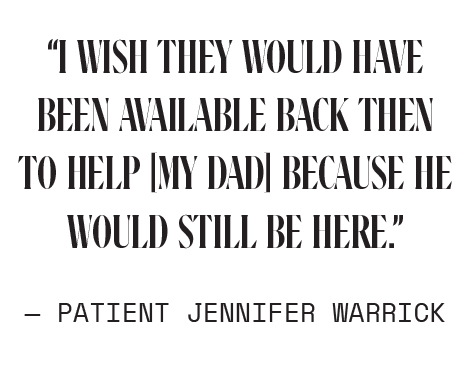GLP-1s Are More Than a Diet Fad for Cleveland Patients Facing Obesity
by Dillon Stewart | Jul. 31, 2025 | 9:00 AM

Megann Galehouse
Jennifer Warrick tried everything: keto and low-carb diets, long walks, Trulicity — a dulaglutide-based GLP-1 for diabetes, which failed to get her blood sugar under control. Nothing worked. She’d finally accepted that she would be overweight forever.
I give up, she told herself. I’m comfortable at 300 pounds. Who cares what anyone else thinks?
Acceptance felt empowering but didn’t change the facts. Her health challenges were compounding. A Type 2 diabetic, like herself, faces a lower life expectancy than non-diabetics by an average of six years. She fought high blood pressure, high cholesterol, neuropathy, fatty liver disease and sleep apnea. Her doctors warned of heart disease and stroke. Even worse, her depression, due to a futile seven-year fertility journey and the death of her father, made the overeating worse.
“My mental health was broken,” says Warrick, an Elyria native. “Everything started piling up.”
In 2022, doctors removed a lump in her right breast. A half-year later, her vision was fading. Her husband asked why she always needed so many lights on, why she was buying extra lamps and cabinet lighting, why she wouldn’t drive at night. “Everything just started getting dark,” Warrick says.
At just 47 years old, she was diagnosed with diabetic cataracts. This is something people usually get in their 60s, she thought. I’m too young for this. Her mom reminded her that her father, a Type 1 diabetic, also had cataract surgery in his 40s. One day in 2005, on the way home from a dialysis appointment, her father’s blood pressure plummeted. He passed out, crashed his car and died in the hospital. He wasn’t even 50. Warrick realized she was on the same path.
“It triggered something in me,” she says.
Related: Find the care for you by browsing our 2025 list of 1,140 Best Doctors in 75 specialties.
Today, Warrick feels like she’s living someone else’s life. She’s dropped 130 pounds. Her hemoglobin A1C (a measurement of blood sugar levels) is down from 10.1 to 5.2. Under 7 is the goal for a diabetic. Her LDL cholesterol has dipped below 100, the healthy target, and her triglycerides have gone from extremely high to mildly high. Her mental health has improved, and so has her quality of life. She walks and plays with her nieces and nephews — all 17 of them.
Her secret? Mounjaro. While they differ slightly, GLP-1 medications like Ozempic, Wegovy and Mounjaro are the most controversial, popular and promising treatments for chronic obesity. They’re hard to get and wildly expensive without insurance. They have side effects and a stigma. But for those whose lives have been changed, GLP-1s are the solution they’ve sought for a lifetime.
“My husband and I just feel so much better,” says Warrick, whose husband is also taking GLP-1 medication. “There’s a more positive outlook on life. The GLP meds have changed my life.”

Darla Rini struggled with obesity since she was a child. When a weight-related illness sent her to the hospital at about 12 years old, she remembers her dad saying, “I swear, if there is a day where something as simple as a shot could help you boost your weight loss, I will do anything I can to help you with it.”
“It was like, Yeah, sure, one day,” she says. “It felt like a dream. And then, here it is.”
In college, Rini gained “more like the freshman 60,” topping out at 267 pounds. In 2023, her doctor said Ozempic could help her. No way, she thought. I’ve heard that a million times. But since then, the now 24-year-old is down to 144 pounds. The shocking results turned her into an evangelist for the drug.
“It totally changed my relationship with food,” says Rini, who was raised in and now works in the food and beverage industry. “Before I was on the medication, I would lick my frickin’ plate. Now, it’s something almost in my head that tells me to stop.”
GLP-1 drugs are not new. The first GLP-1, which derives from the saliva of a lizard, was discovered in the ’90s. The Food and Drug Administration approved the first commercial application, Byetta, to treat diabetes in 2005. In 2017, Ozempic (a semaglutide) gained approval for the same purpose. When clinical trials and patient observations showed significant weight loss, researchers worked quickly to bring them to market. In 2014, the FDA approved Saxenda (a liraglutide), a daily injection that curbs craving in the brain and delays the stomach from emptying to make patients feel full for longer, specifically for weight loss. Seven years later, Wegovy earned the same designation for chronic weight gain as well as heart disease. While not effective for every patient, studies show astonishing results at lowering blood sugar levels and potential at curing a slew of other ailments, from sleep apnea to brain fog.
Suggested: Bernie Kosar Details His All-Natural Fight With Liver Disease and Parkinson's
Attempts to curb America’s growing obesity problem aren’t new. Since the ’80s, the World Health Organization has designated obesity as an epidemic. Recent statistics suggest 1 in 8 people are 30 or above on the body mass index. Forty percent of Americans, according to the Centers for Disease Control, are obese. That’s 100 million people, and 22 million of those cases are considered severe. Eighty-five percent of people with Type 2 diabetes are obese, according to the National Institutes of Health. It’s no surprise that between 2019 and 2023, use of the GLP-1 treatments has grown by 700%, according to one study. In a tracking poll, about 32% of people said they’d heard “a lot” about GLP-1 drugs, up 19% since 2018.
Dr. Mohamed Shahed of Signature Meds in Fairview Park says he’s seen two GLP-1 booms. In 2017, when the FDA approved weekly shots for diabetes, and again in 2021, when the drug was popularized as a weight-loss treatment and patients started asking for Wegovy, Cepbound and Ozempic. This recent spike in notoriety creates the misconception that the short- and long-term side effects are unknown. That’s not true. “We have 20 years of safety data,” Shahed says.
There are side effects, both long and short term. Often, at first, patients report extreme nausea and constipation, which both contribute to a lack of appetite. Users we spoke to, most commonly reported these symptoms. Warrick experienced severe nausea and constipation early, though Rini had only occasional stomachaches. Less food also opens the door for protein and vitamin deficiencies. Many people pair a GLP-1 drug with a B12 shot. A clinical trial suggests that once-weekly Ozempic shots may lower bone density and muscle mass. These drugs aren’t safe for everyone, either. For example, the treatment is especially dangerous for those with the extremely rare medullary thyroid cancer. On a longer timeline of two years, some users have experienced pancreatitis, vision decline and gallbladder issues, though the cases are rare.
Too much of the rhetoric, though, focuses on Hollywood starlets slimming for the red carpet. Why risk short-term discomfort and irreversible long-term effects to lose a few pounds? But that is not the calculation for severely obese individuals. GLP-1 treatments offer a chance at a higher quality of life and help them trim a pharmacopeia of prescriptions, all of which have their own short- and long-term side effects.
After all, when weighed against the most severe consequences of obesity, long-term effects don’t matter much if you’re dead.
After experiencing so much success, Warrick was eager to get her husband on a GLP-1. He had struggled with his weight and was more than 500 pounds at his highest. COPD exacerbated the problem, making him sedentary. Warrick could envision a better life as a couple if they could make these health improvements together.
Warrick had no problem getting a Mounjaro prescription. With an A1C higher than 7, her diabetes covered her. Yet, obtaining the medicine wasn’t as easy for her husband. Since many GLP-1 drugs were approved to treat diabetes, health insurance companies won’t approve their use without an A1C of 6.5%. Instead, thanks to the Medicare Prescription Drug, Improvement, and Modernization Act of 2003, Medicare and Medicaid consider weight loss treatments cosmetic, rather than a chronic illness. The rest of the insurance industry follows suit. Warrick’s husband’s doctor gave him a prescription, but without a diagnosis of diabetes, the cost to fill it was more than $2,000 per month. She pays nothing.
The couple began looking at compound pharmacies at the advice of his doctor. Landing on Buderer Drug Co. in Avon, they were able to get the drug for about $250 a month, roughly a month’s worth of groceries. Still expensive, but achieving the results that Warrick experienced would be worth the money.
Compound pharmacies are online services, like Hims and Hers, and physical locations. These independently operated pharmacies get drugs from unlicensed sources, usually from outside the country, and make their final concoctions onsite. They are almost always cheaper for the uninsured, and sometimes, the pharmacies can tailor offerings to a patient’s specific needs. Some doctors, however, fear contamination, incorrect dosage and unclear ingredients.
Many turned to compound pharmacies between 2022 and February 2025, when the FDA added and then removed Ozempic from the drug shortage list. The administration loosened restrictions to handle the shortage, but in March, that grace period ended. Now, big pharma companies are pushing the FDA to crack down.
“I have seen serious side effects in some cases. You don’t actually know the dose of the medication you’re getting,” says Dr. Ian Neeland, co-director of the University Hospitals Harrington Heart & Vascular Institute’s Center for Integrated and Novel Approaches in Vascular-Metabolic Disease, CINEMA for short. Instead, he suggests those who struggle to afford these drugs look for patient assistance programs. “It’s just not regulated at all. It’s a bit of the Wild West.”
For people like Warrick’s husband, though, these sources feel like the only option. Since taking it, he’s dropped more than 50 pounds. He’s joined his wife on daily dog walks. They now order small pizzas rather than extra larges — and typically have leftovers. More important, he’s stopped medication for cholesterol, and he’s only taking one blood pressure pill. Fewer prescriptions mean lower cost and fewer side effects to worry about.
“We’re dropping meds left and right every time we go to the doctor,” says Warrick.
John Giangrande can relate. At 5-foot-4 and 210 pounds, the 62-year-old’s glucose was at pre-diabetic levels. He had a fatty liver, and his blood pressure and cholesterol were high. All while fighting melanoma. He lost a little bit of weight with lifestyle changes, protein shakes and daily walks, but as soon as he began taking Ozempic, the weight melted off. His ailments improved.
“The numbers were absolutely amazing,” he says. “It was like a magical cure.”
Yet, after about a year, insurance refused to cover his Ozempic any longer, citing his improved medical results. Quickly, he began gaining weight again, going from his pinnacle of 171 to 190. Since then, a lower-dose semaglutide obtained by Signature Meds through a compound pharmacy has helped him stave off additional weight gain. He’s paying $650 a month compared to the $25 he was paying for Ozempic. It’s hundreds of dollars less than he would have paid for Ozempic out of pocket, but it’s a belt-tightening cost.

Rini, on the other hand, has never gotten insurance to cover the medication, despite having a fatty liver and doctors saying she was on track for diabetes and heart disease. She pays $1,200 a month for Ozempic.
For many, the results are worth it. Dr. Shahed tells the story of an 80-year-old female patient who lost 60 pounds in six months, allowing her to reduce her medication from 12 to three pills. Her diabetes went into remission, and she no longer complained about back and knee pain. Medicare patients can save about $6,000 per year in medical costs, he says.
“Insurance would rather treat the disease than preventative medicine,” Giangrande says. “Hollywood gives GLP-1s a glamorous weight loss reputation. It’s a feature, but for me and my wife, it’s about the medical benefit behind it.”
Dr. Shahed started Signature Meds in 2018. Over the past two decades, he’s helped patients with weight loss, but he never thought he’d need to use the treatments on himself. In 2020, a sedentary lifestyle slowly pushed him even further overweight. The pandemic was a scary time for health care workers, and the self-described “stress eater” would binge late at night. While he was not experiencing severe health complications, with a BMI increased to 33, which is considered obese, he felt it was only a matter of time. Since using GLP-1 drugs, he has lost 50 pounds and reduced his BMI to 25.5. He’s working out more thanks to regaining energy.
“At 52 years old, I feel better now than when I was 25 years of age,” Shahed says. “I was able to break that vicious circle.”
Too often, Shahed sees patients yo-yo. They make great progress for a year and then plateau. Or they get off the shot, sometimes because their blood sugar has left the diabetic range and insurance will no longer cover it, and gain all the weight back. Some don’t lose weight at all because they continue to eat poorly and in large quantities despite reporting feeling full.
“They can basically give you a new reset point in your life,” he says. “But you have to work on your diet and exercise. You cannot keep having that same bad lifestyle, eating out, eating junk food and not exercising because these medications are not going to work for you.”
Typically, when someone asks to be treated with a GLP-1, he makes them wait a month and asks them to show some measure of weight loss before he makes a prescription. It’s certainly not a starting point for someone who is 10 pounds away from their goal weight or “a magic bullet” that will “make you look like a movie star,” he says. “It always starts with a proper diet and exercise,” he says. “Your weight did not come overnight. It came over periods of months and years. You need to change your lifestyle. This medicine is a jump-start.”
“Success helps build success,” Giangrande says of his experience with the process. “You see that financially. If you write a great article, I’m sure that opens doors. I’m no Olympian, but GLP-1s helped us make great strides in getting more active.”
Rini has also worked hard to build a healthy lifestyle outside of her medication. She worked with a nutritionist and a physical trainer, with whom she still checks in to create weekly exercise agendas. A student at Cuyahoga Community College’s Culinary Arts and Hospitality Management program, she’s parlayed her health kick into a new career. She’s now the general manager at Rejuve, a health food and juice concept on Public Square created by her and her father, William Rini, the chef and owner of A Taste of Excellence catering.
Now, she’s weaning off Ozempic, a process of slightly cutting the dosage and monitoring weight before cutting more. She expects to be off the medication in about six months. She’s confident in the new lifestyle the medication helped her build, but there is fear in abandoning the thing that worked.
“I never want to get to that weight again,” she says. “I don’t think I’m ever going to let that happen, but I know there’s always the possibility of getting back on it.”

More than the shots inspired Warrick’s “trigger moment.” At her lowest point, Warrick’s nurse navigator suggested she apply for CINEMA at the University Hospitals Harrington Heart & Vascular Institute’s Center. Facing a medley of ailments means keeping track of multiple doctors, who do not always communicate and collaborate on care.
CINEMA sets out to break down those communication barriers by employing a multidisciplinary team of doctors, educators, dietitians, nurses and pharmacists who create a coordinated and cohesive game plan for each patient. Promoting lifestyle changes, education and counseling, in addition to traditional medicine, the program focuses on diabetes and pre-diabetes but also addresses related illnesses such as obesity, chronic kidney disease, sleep apnea and liver disease. The program, the only of its kind in Ohio, according to UH, is proactive, not just treating existing conditions.
“This is a one-stop shop,” says Neeland. “This is the next phase in the future of care, trying to address the problems and the pitfalls and defects of current care models to make things run more smoothly, more efficiently and better for patients, better for outcomes.”
Still, GLP-1s play a major role. About 20% of patients are on a GLP-1 when they arrive at CINEMA, and out of the program’s 800 patients, about 60% are on GLPs. The result is a reduction in diabetes-related problems, blood pressure and cholesterol.
“During our program, people lose weight,” says Neeland. “And they feel better.”
While he turned to Signature Meds, not CINEMA, Giangrande also recommends finding a support system that includes professionals. Committing to a healthier lifestyle with his wife has even given him, in the words of South Park, an accountabilabuddy. Warrick agrees with the power of a couple making changes together.
“I would never blame [my husband] for me putting weight on, because I love that man,” she says. “But now he’s more active and able to keep up with me better. We’re not out of breath all the time.”
The quest to solve obesity won’t end with GLP-1 shots or even integrated care.
In June, trials were released on new formulations that may be even more effective. The results of the first generation of receptor-agonist GLP liraglutide-based drugs saw about 8% body weight loss over the first year. The second generation, like Wegovy and Zepbound, hit 25% or more on average with just one shot a week. Meanwhile, a study published in the medical journal Cell suggests a beta-2 molecule, administered orally, could lessen muscle loss compared to Ozempic, a problem, especially among older adults.
Plus, who wants to take a shot? New formulations could be available in pill form. Pills already exist, such as the semaglutide Rybelsus, which is taken daily. While Rybelsus helps regulate blood sugar, though, it hasn’t shown the same efficacy in weight loss.
Plenty of discussion also surrounds GLP-1 drugs’ future beyond severe obesity-related health issues. Some people have compared them to Botox. Dr. Alan Scott pioneered the use of Botox in the 1970s to treat strabismus, or misaligned eyes, and blepharospasm, involuntary eyelid spasms. Only in the early 2000s did the medicine start being used to fight wrinkles. Now, it’s come full circle with the medicine being used to combat Cervical dystonia, chronic migraines and excessive sweating.
Similarly, GLP-1 drugs started out as treatments for diabetes before being used for weight loss, and they are now moving into new territory. Some users speak of GLP-1 as a wonder drug, treating everything from brain fog to low energy. Studies suggest the potential for Alzheimer’s prevention, and some say it’s helped them fight substance use disorders and addictive behavior, such as shopping and gambling addictions. A longtime wine drinker and passionate bourbon collector, Giangrande has cut out drinking almost entirely.
“I still collect bourbon. It tells stories. When we entertain, I still enjoy some bourbon once in a while,” he says. “Now, if we open a bottle of wine, we’re gonna pour out two-thirds of it after a week. I don’t really drink much anymore.” In his opinion, “the GLP-1 directly caused that.”
These hypotheses are certainly promising, but there is no conclusive evidence that points to those results.
Some of those positive results might be connected to solving other problems or even placebo effects. Diabetes, sleep apnea, obesity and fatty liver have all been linked to brain fog, fatigue and cognitive decline. When those are treated, that could lead to the improved cognition and energy some are reporting. Drinkers could simply be too full to imbibe.
“There’s no good scientific evidence that GLPs impact mental health, mental disorders, concentration, cognition, addiction — it’s all anecdotal. Through its work on the brain, it’s possible,” says Neeland. “General health is all related to the brain. But there are no good clinical trials to show documented evidence. It’s still a hypothesis, but it is interesting. There’s probably a lot of interconnectivity and crosstalk there that we just don’t know yet. I think that it’s certainly a wide open area for research that could be very beneficial.”
Regardless of the side effects, the stigma or even the future, for patients like Warrick, the medication has been life-affirming. But it’s still hard to believe. So much so that Warrick’s husband refuses to buy new clothes.
“His clothes just swim on him. He looks like he’s wearing a dress,” says Warrick. “He’s like, ‘I’ve been a big guy my whole life. I don’t believe that I’m smaller.’ That’s the mental side.”

This summer has been a heavy one for Warrick. In July, she turned 49, meaning she outlived her father. It’s a milestone she feared she wouldn’t reach.
“I’m very emotional about it because I’m glad that I have these things now to help me with my health,” she says, “but, man, I wish they would have been available back then to help him, because he would still be here.”
She’s still here, though. She’s living a fuller life than she has in years. This year, she and her husband along with her sister’s family visited Tennessee. Together, they hiked the Smoky Mountains and kept up with the kids. The couple brought his oxygen tank along just in case, but he never had to use it. He does chair exercises, and she does yoga and hikes the Metroparks with her sister. She is looking forward to retiring in 15 years, envisioning a life on the road in an RV, seeing the country with her husband.
“There’s no way we could have done any of these things before,” she says. “I just thank God every day that we found this medication, because it’s changed his and my life so much.”
For more updates about Cleveland, sign up for our Cleveland Magazine Daily newsletter, delivered to your inbox six times a week.
Cleveland Magazine is also available in print, publishing 12 times a year with immersive features, helpful guides and beautiful photography and design.

Dillon Stewart
Dillon Stewart is the editor of Cleveland Magazine. He studied web and magazine writing at Ohio University's E.W. Scripps School of Journalism and got his start as a Cleveland Magazine intern. His mission is to bring the storytelling, voice, beauty and quality of legacy print magazines into the digital age. He's always hungry for a great story about life in Northeast Ohio and beyond.
Trending
-
1
-
2
-
3
-
4
-
5










